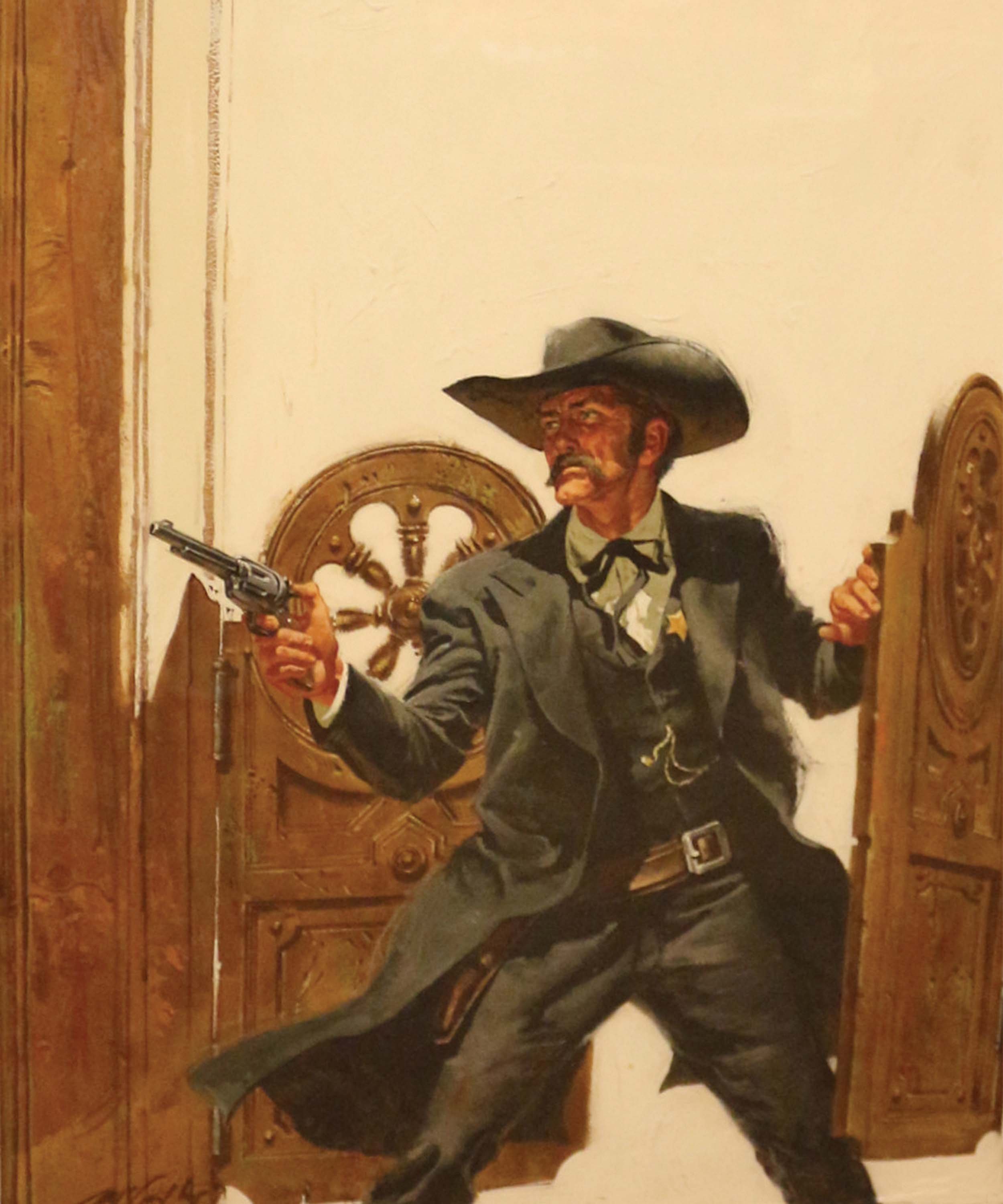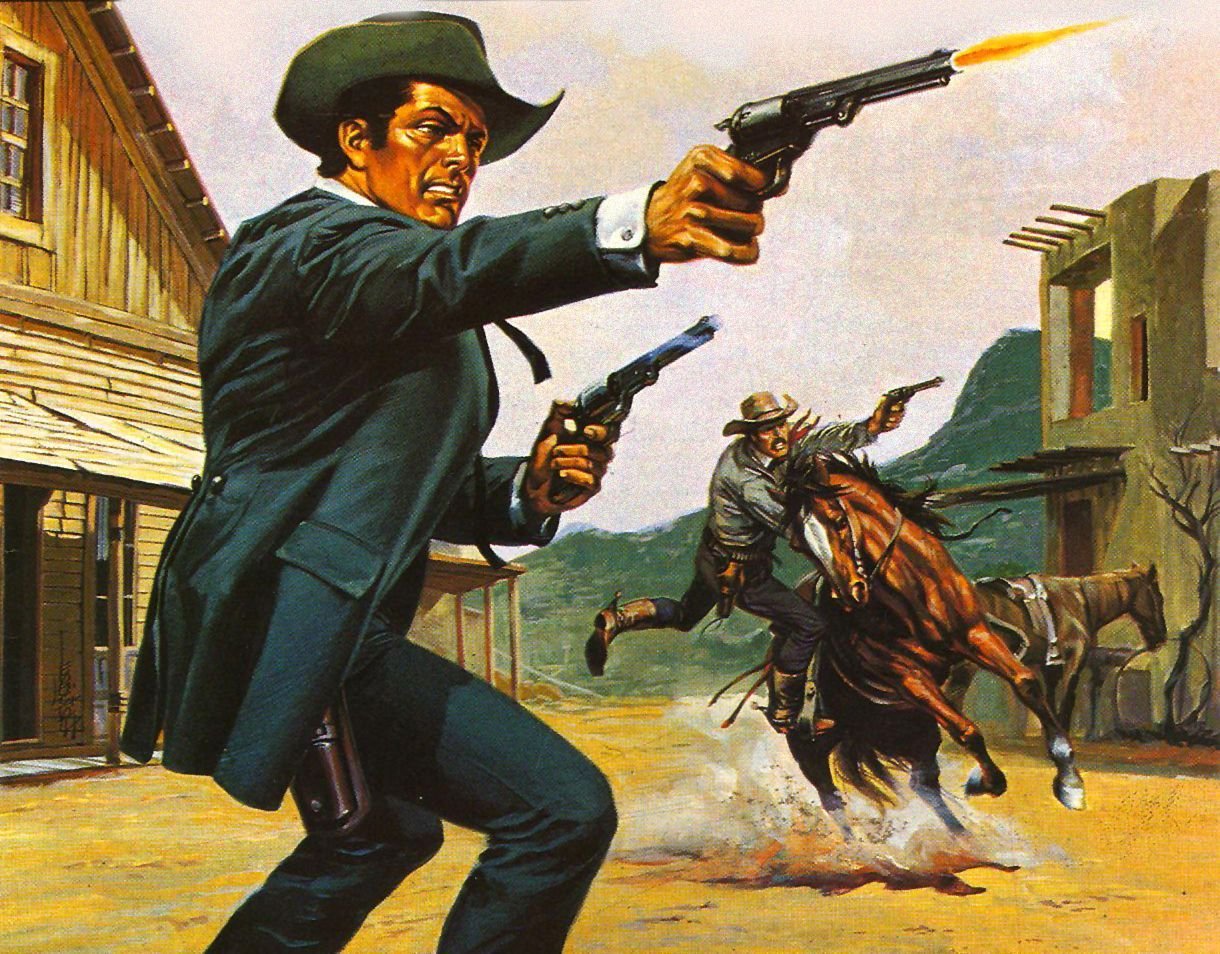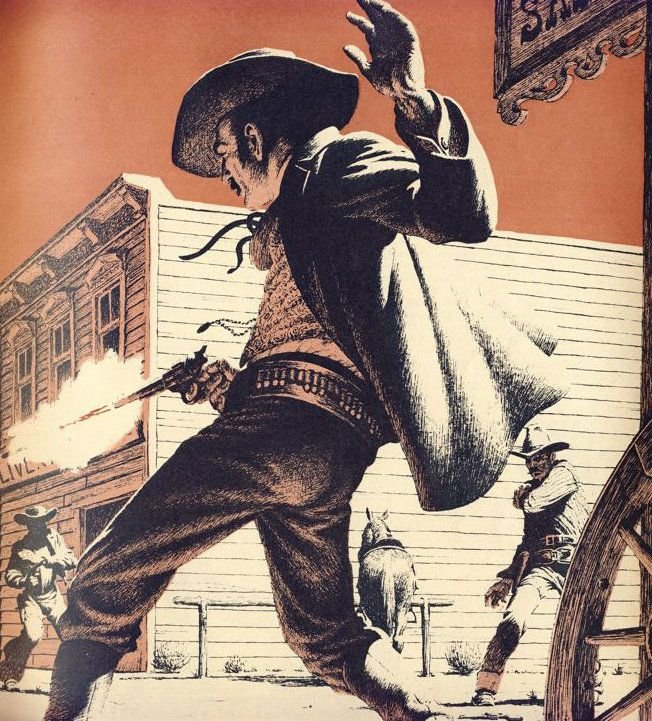Quicker Combat for Boot Hill
Boot Hill is about as old as a TTRPG can be, published just one year after indie darling, “Dungeons & Dragons”, from the same infamous publisher, Tactical Studies Rules. Yet D&D was the game that launched a thousand retroclones, while Boot Hill sired relatively little progeny. By progeny, I don’t just mean new editions (of which it has a couple) or other Wild West themed games (of which there are many); I mean a Wild West game that takes Boot Hill as its starting point and introduces a modern, more elegant take on it, similar to games like Black Hack, Into the Odd, or Old-School Essentials do, to varying degrees, for D&D. Well I guess I’ll throw my hat in the ring. Can I make a Boot Hill retroclone?
Probably the reason D&D has become an international, generation-spanning phenomenon while Boot Hill is a footnote in the TTRPG history books is that early D&D provided enough to imagine what a campaign would look like. The referee would make dungeons, and the players would explore them with their characters who would grow in wealth and power. They might also travel overland between settlements and said dungeons. Boot Hill, on the other hand, basically only has rules to simulate cowpokes shooting each other, punching each other and—more often than not—killing each other. Which is undoubtedly an important aspect of a Wild West game, but does seem incomplete as a roleplaying game as opposed to a wargame. But for those in the know, a super deadly, barebones game could be all you need for an amazing game of intrigue and player choice. And you don’t take my word for it; the blogpost “Boot Hill and the Fear of Dice” is better at selling a campaign of Boot Hill than anything I could squeeze into this paragraph. So for my retroclone, I will probably flesh it out somewhat. But before adding new stuff, I need to see if I can make what is already in there, those core combat rules, shine.
Be Rootin’, Be Tootin’, and by God Be Shootin’
This is the most iconic part of Boot Hill and what the lion share of the text contained in the first edition of the game devotes its time to explaining: gunfights. Because Boot Hill was released in that liminal time when TSR was in fact producing roleplaying games but thought they were making war games, Boot Hill is best understood as a game for simulating gunfights between classic Wild West personalities (a whole mess of which are statted up in the back). Unfortunately, the shooting rules are… to put it politely, quite baroque. I will walk you through the rules, as presented in the original Boot Hill, before I swoop in to save the day by claiming that I fixed it. We must skip past character creation and determining who shoots first (both important issues deserving separate attention) to get to our object for this experiment.
We are answering one question: if I shoot my gun at a person, what happens? Well first, we need to see if you hit the person with your bullet. As a starting point, you have a “Gun Accuracy” ability score, which ranges from -9 to +20. You also have a “Bravery” ability score which separately provides a modifier to your Accuracy, which modifier ranges from -6 to +15. You will add this cumulative bonus/penalty to a bevy of other modifiers (see the Hit Determination Chart table below), to determine if you hit your target. You must then roll the percentile dice (i.e., a d100) and, if you roll equal to or below the number generated, you hit! Unless they are behind hard protective cover, in which case you may find out you missed after all in the next step. Do this for each shot if firing multiple shots this round (the ability to do so depends on the gun used).
Now that we know whether you hit your target, the next question is how much it hurts them. This two-part structure is nothing new to those familiar with D&D. In a typical D&D, you roll “to hit”, then you roll for damage. Sure, the to-hit roll presented above is a bit more complicated than your run-of-the-mill elfgame’s, but it is not conceptually different. But with damage, we are going to need to add a step to the familiar process. We must determine the location of the wound as well as the severity of the wound. I will spare you the additional process (which can necessitate as many nine (9) dice rolls) if you are firing a shotgun or scattergun instead of your standard pistol or rifle. For each hit, roll a d100 first to determine which body part was hit. If that body part is behind cover, the hit is negated entirely. Then, based on which body part, roll another d100 to determine what type of wound it is. The wound chart, reproduced below, is actually pretty fun and nifty. For instance, a wound in the left shoulder has a 10% higher chance to be mortal than a wound in the right shoulder, despite being equally likely to be hit; this is likely to reflect that a very vital organ (i.e., the one hopefully pumping blood to your brain as you read this) resides in and around the left breast.
The Good, The Bad and the Ugly
My problem with the above is simply that there are too many steps and too much time between the player declaring that they shoot their target and determining the outcome. It is terribly inelegant. Maybe this is because I have gotten used to Into the Odd, Errant, Cairn, Prismatic Wasteland and all of the similar systems that ditched the to-hit roll (which I think was originally proposed at B/X Blackrazor, but prove me wrong in the comments), but I have developed a real preference for games where, if combat is to be had, it is deadly and quick. I wouldn’t settle for a game that is not deadly but quick (why fight, if there is no chance of dying? Impact is important). I certainly wouldn’t play a game where combat is neither deadly nor quick (though I can think of a few…). Boot Hill is plenty deadly; every bullet has a chance of killing you dead then and there, but its problem is that it is slow as all get-out. I don’t think I can make it as quick as Into the Odd combat, which doesn’t care too awful much about which body part is hit, but I can try my darnedest.
First off, I modified the ability scores. Instead of being a morass of statistics (Speed goes from -5 to +22, Accuracy from -9 to +20, Strength from +8 to +20, and Bravery [which isn’t really used directly by the player characters in Boot Hill] from -4 to +5, and all of these are determined by rolling d100s on separate charts), I am going with the tried and true 3d6 in order for stats, producing stats from 3 to 18 in an easy bell curve. And as a core mechanic, another classic from D&D-a-likes: roll d20 under your stat to succeed at a relevant task. Roll-under is just so elegant.
However, there is some granularity that we need to add back if we are going to attempt to adapt something as granular as Boot Hill. For that, I will adopt the “roll high, under” or “blackjack” variant of roll-under used by White Hack or Errant (described in greater detail in this blogpost from Ava at Permanent Cranial Damage). In that variant, the difficulty of the task is represented by a “difficulty value” that the d20 must roll above to succeed, in addition to rolling below their ability score. So the higher the difficulty and/or the lower your score for that ability, the more likely you are to fail, and vice versa. We haven’t yet added much complexity. Why a d20? I think a d100 has its place, but not when most of the odds are measured in increments of 5% to 10%, which is the case in Boot Hill. In that case, just use a d20, where each number has a 5% chance of occurring. The d100 feels needlessly complicated.
Next we have to attack the issue of the to-hit roll. While I just praised games that jettison the to-hit roll, those are games where you are bashing each other with swords and whittling down on your opponent’s hit protection until the first person drops. In these games, the HP usually represents your ability to avoid deadly hits. In a western shootout, on the other hand, the real question is “do I hit my opponent?” A cowpoke whose gun never misses would be the stuff of legend, not just every hired gun. Additionally, a lot of the strategy in Boot Hill combat revolves around not getting hit, since a bullet from any gun can kill you dead. I want to keep one roll though. So how do I square this circle?
A single d20 roll will determine if you hit, where you hit and how deadly the wound is. That is a lot to pack into a single roll, so how do I do it? First, I kept most of the accuracy modifiers from Boot Hill, condensing some of them, and in all cases keeping the math the same (e.g., a +20% chance on a d100 roll over system is a -4 DV on a d20 roll high, under “blackjack” system). This is pretty straightforward and in no way revolutionary. So you use this table to determine the DV that you are rolling equal to or above and roll a d20 trying to get between that number and your Accuracy ability score. If you do, you hit and we move to the next step. If you don’t, you miss.
If you hit, no additional roll is needed. Instead, you just take the d20 you rolled and consult the following table to determine both where you hit and how fatal the resulting wound is. Just like in the original game, if the wounds table indicates a body part that is behind hard cover (e.g., a wall), there is no hit. Hiding behind cover is very powerful in Boot Hill. If you roll a critical failure (a natural 20) the gun jams, rendering it inoperative until it is cleared (which takes 3 rounds). If the shooter fails the save but rolls a natural 1, it is still a hit but they roll 2d8 on the wound table to determine the hit location and wound. Like Boot Hill, there are also some more complicated rules for shotguns and scatterguns, but I will save you from that level of nitty gritty.
A couple choices are being made with this new wounds table, both of which are influenced by the “blackjack” system. The first is having the deadliest results at the extremes. This is because success at either end represents a good shot: either you rolled low but also have a low DV, which represents nailing a clean shot, or you simply have a high accuracy but rolled under it anyway, representing a very skilled gunfighter. The middle results are less impressive: it doesn’t take very high stats to succeed when you roll a 10, and the DV could still be rather high. The second choice was to combine body categories. This was not only because there are more limited results in a d20 roll versus a d100 but also because many of the categories in the original Boot Hill are not mechanically differentiated. It doesn’t much matter if you get shot in the chest or groin, other than one being more likely to produce a mortal wound. However, an injury in the legs does have the effect of reducing your speed and an injury in your dominant hand can force you to shoot with your non-dominant hand. There are no ambidextrous cowpokes in the west; sorry partner. So I combined some of the categories. If it’s purely flavor, when you get shot in the torso, I’d let the player describe if it’s their chest, abdomen or shoulder. Nonetheless, the odds of each body category are still the same between the new and old wound tables and the likelihood of a wound in a particular body part producing a particular type of wound are also the same. So the results should be roughly the same as what is produced by the original Boot Hill system but with a single d20 roll instead of three d100 rolls. How’s that for elegance?
[Another exciting part of the above table is the possibility of having different enemies having specialized wound tables for their gun/ranged attacks or their brawling/melee attacks, separate from the table used by the players. This is getting a bit far from the core cowpoke fantasy, but imagine a separate table for when your cowpoke gets attacked by a dragon breathing fire at you. There are a lot of possibilities with the approach I have sketched above, the surface of which I am only starting to scratch]
In this endeavor, while trying to stay true to the original Boot Hill, I am not striving for excessive deference. Instead, where a new trend in TTRPG design has emerged since the 1970s that is a good fit, I plug it in. For instance, the existing wound system of light, serious and mortal wounds immediately called to mind the harm tracking system from Blades in the Dark. In Blades in the Dark, there are different categories of harm and making a harm beyond Severe is Fatal. This graphic from the rule book does an excellent job of explaining how this system works. For Boot Hill, this would add a fourth category of wounds, which is helpful for less deadly endeavors like fist fights. But it also preserves the inherent deadliness of Boot Hill combat: if you receive a mortal wound, you die. A single bullet has the potential to kill anyone.
O.K. but how does it work Corral
It may be useful to provide an example of this system in action. This example is just showing how a few shots in a single round would play out, not an entire gunfight.
In this example, the rustler Ike Clanton is firing his six-gun at the lawman Morgan Earp in a narrow 15– to 20-ft-wide lot on Fremont Street, just down the street from the O.K. Corral. Ike is a fair shot with a 13 Accuracy but has already been seriously wounded in the first round of combat by Morgan’s brother, Virgil. Ike fires three shots at Morgan, shooting at the hip from medium range. The DV is 5 (+4 for the two extra shots, +1 for his wound; medium range and neither party is moving, so those factors do not impact the DV for this shot). Ike’s player rolls three d20s, one for each shot. The first is a 16 which is a miss because it is above Ike’s Accuracy score. The second is a 3 which is a miss because it is below the DV. The final shot rolls a 5. This is equal to the DV and below to his Accuracy score, so it’s a hit! Consulting the wound table reveals that Morgan suffers a minor wound in the torso. The player writes down on the wound tracker that he took a bullet in the stomach.








